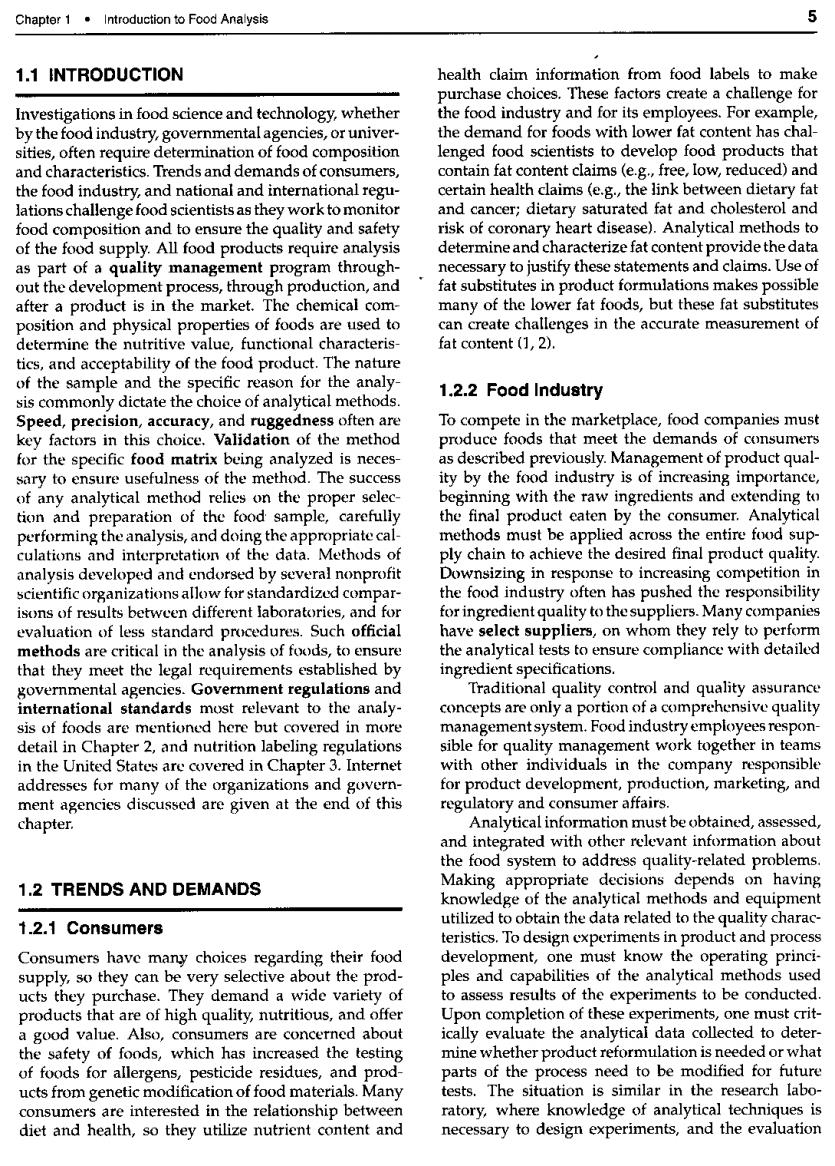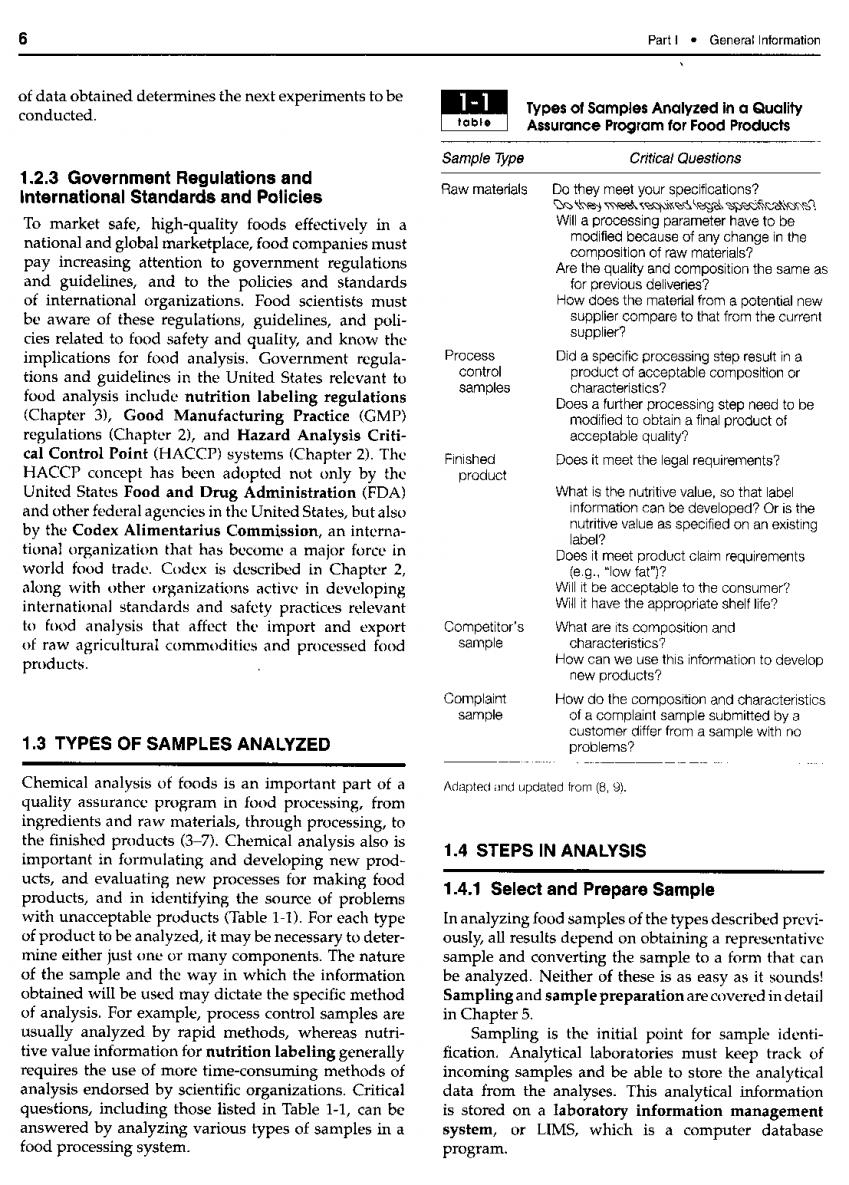
7 chapter Introduction to Food Analysis S.Suzanne Nielsen 1.1 Introduction 5 1.2 Trends and Demands 5 1.2.1 Consumers 5 Opetvo of the Mthocingo of Food Compositior 1.2.2 Food industry 5 1.5.4 Validity of the Method 7 1.6 Official Methods 9 1.6.1 AOAC International 9 1.6.2 Other Endorsed Methods 10 1.4.1 Select and Prepare Sample 6 1.7 Summary 11 1.4.2 Pertorm the Assay 7 1.8 Study Questions 12 1.4.3 Calculate and Interpret the Results 7 1.9 References 12 1.5 Choice and Validity of Method 7 1.10 Relevant Internet Addresses 12

Chapter 1.Introduction to Food Analysis 1.1 INTRODUCTION health claim information from food labels to make rchase choices These factors c ate a challenge for Investigations in food science and technology,whether the food industry and for its employees.For example by the ood industry.governmentalagencies.or univer. the demand for foods with lower fat content has chal sities often require determination of food composition lenged food scientists to develop food products that and characteristics.Trends and demands of consumers, contain fat content claims(e.g.,free,low,reduced)and the food industry,and national and international regu certain health claims (e.g.,the link betwe dietary fa lations challenge food scientists as they work to monitor cancer;dietary satu rated fat and cl an food composition and to ensure the quality and s oronary heart alytica of the foodsupply cts require er p a qu de opme in the fat he a pr to nges in the accurate me unctional charact fat content (1 2) and aco of the samnle and the specific reason for the analy sis commonly dictate the choice of analytical methods 1.2.2 Food Industry Speed,precision,accuracy,and ruggedness often are To compete in the marketplace,food companies must key factors in this choice. Validation of th method oduce foods tha the demand nsumer for the specific food matrix being an e as desc t of product qua ary to sure usefu or the met of any analytic met on g W ng da chai the desired final duct quality nd r】nn e to incre the food industry often has pushed the responsibility different laboratories and f for ingredient quality to thesuppliers.Many companies wvaluation of less standard procedures such official have select suppliers,on whom they rely to perform methods are critical in the analysis of foods,to ens the analytical tests to ensure compliance with detailed that they meet the legal requirements established b Government regulations a Traditional quality control and quality a assura nternational standards mo t relevan 0 analy pts ar nt systen Ch 1 qua the tn the for duct d. duction.marketing,and ar the of this umer affairs hapte Analytical information must heobtained assessed and integrated with other relevant information about the food system to address quality-related problems 1.2 TRENDS AND DEMANDS Making appropriate decisions depends on having kn dge of the ods anc omen 1.2.1 Consumers utilized too ain the data re a to the qualty chara o de Con sumer have many choice supply,so the regarding th ir fo ope ey ca very se d evaluate the analytical data collected to dete of foods,which has increased the testing mine whether product reformulation is needed or wha of foods for allergen parts of the process need to be modified for future ucts from genetic modification of food materials.Many tests.The situation is similar in the research labo consumers are interested in the relationship betweer ratory,where knowledge of analytical techniques is diet and health,so they utilize nutrient content and necessary to design experiments,and the evaluatior

6 Part I.General Intormatio of data obtained determines the next experiments to be 1-1■ conducted. Types of Samples Analyzed in a Quality Assurance Program for Food Products Sample Type Critical ouestions 1.2.3 Government Regulations and International Standards and Policies Do they meet your soecifications? Tomarke high -quality foods effectively in a ed bec se of ar I an ketplace,food companies must nge in the in ac 80 en regulation Are the quality and c osition the same a ideli the or previous a idol compare to that from the curren cies related to food safety and quality,and know implications for food analysis. tions and guidelines in the United States relevant to Did a spec。 food analysis include nutrition labeling regulations (Chapter 3),Good Manufacturing Practice (GMP) egulat (Chapte and Hazard Analysis Criti Control HACC.P)system (C hapter 2. The Does it meet the legal requirements? nd ot only product can be ed?Or is the ization that has bo world food trade Codex Do along with other organizations active in deve M it be acceptable to the consumer international standards and safety practices relevant Willit have the appropriate shelf life to food analysis that affect the import and export Competitor's What are its composition and of raw agricultural commodities and processed food use this information to develop new broducts? How do the cor sample ted by 1.3 TYPES OF SAMPLES ANALYZED ample Chemical nal of foods an part of ted:du均ted from. from tant in 1.4 STEPS IN ANALYSIS ts and evaluatin es fong akin 1.4.1 Select and Prepare Sample with unacceptable products (Table 1-1).For ach ty in analyzing food samples of the ty of product to be analyzed,it may be necessary usly all results depend on obtai mine either just one or many components.The nature sample and converting the sample to a form that car of the s nple and the way in which the information be analyzed.Neither of these is as easy as it sounds ained will be used nay dictate the spe cific method Sampling and sample preparation are covered in detail ample,proce ol samples are in Chapter 5. rapid Sampling is the initial point for sample identi- utrition oratories must keep track c th a hy ng sample L: those listad in Table 11 es of samples in a LIMS,wh ch is food processing system. P9

Chapter 1.Introduction to Food Analysis 1 1.4.2 Perform the Assav in the pilot plant may be obtained quickly withamois mit that Performing the assay is unigue for each component or characteristic to be analyzed and may be unique time-consuming hot air oven method (see Chapter 6) to a specific type of food product.Single chapters in this book address sampling and sample preparation 1.5.3 Consideration of Food Composition and Characteristics the bo andling (Chapter 4),white the Proximate e analysis of foods ant foons h hapter assays dotails regarding chemicals teas an ethods is affected by ratus,and step-by-step instructions are found in the referenced books and articles.It should be noted that especially lipid,protein,and carbohydrate).For exam numerous analytical methods utilize automated instru- ple,high-fat or high-sugar foods can cause different ypes of interferences than low-fat or low-sugar foods Digestion proce resa d extra action steps necessary for 1.4.3 Calculate and Interpret the Results s can be very nt on the Tomake decisions and take action based on the results for a specific food co nt hut multinl tochni or characteristics the Association of Official Analytica C),suggeste 1.5 CHOICE AND VALIDITY OF METHOD nto ma (012)i ngle cor 1.5.1 Characteristics of the Method Eoods were ratod as "hio wor"medium f carbonydratend rnwhic T the three nutrients expected to have the strongest effect select or modify methods used to determine the chem on analytical method performance.This created nine ical composition and characteristics of foods,one mus dium,and low lev be familiar with the principles underlying the pro of SoOmbtionsafhigt,med and are useful ormalized basis (i Ca at use or a ne ormalized to total 10)cenera ideally would be geared to handle each of the nine com- 1.5.2 Objective of the Method binations,replacing more numerous matrix-dependent methods developed for specific foods.For example measurement.For exampl e method migh for rapte which ar n-fat,m nutritional labeling d to reference.definitive.official.or primary are m fat ahienadehnepuYpetaosHaaaymtPe eral method couid more rapid secondary or field methods may be more applicable on the manufacturing floor in a food pro ciation of Cereal Chemists(AACC)has approved a method studied using this approach(12). as a rapid,seco tor sugar ana 1.5.4 Validity of the Method corre hi uid chro by (HPLC)(see per ht Moisture content data for a product bei ing developed

8 PartI.General information 1-2 table Crlterla for Choice of Food Analysis Methods Characterstlo Critical Questions Is the pro Precision 冰nana9Angn9小& ·Accuracy e percent recovery? uch samole is needed? toi your needs? Reagents Are they stable?For how long and under wha 。Equipment eo8ee82Yoataiosghtorgodeaechangesntheregonte2 and personnel? d to ha? ep8esegcsonamdstd snchange in metnod wortn the trouble of the change? Are special precautions necessary? of the procedures and reagents? Fat 100% Fat 100% 毁 3 甜激 骝激 carb9rnt歌 脚教 906a 1-1■ Schematic layout of food matrixes b figure